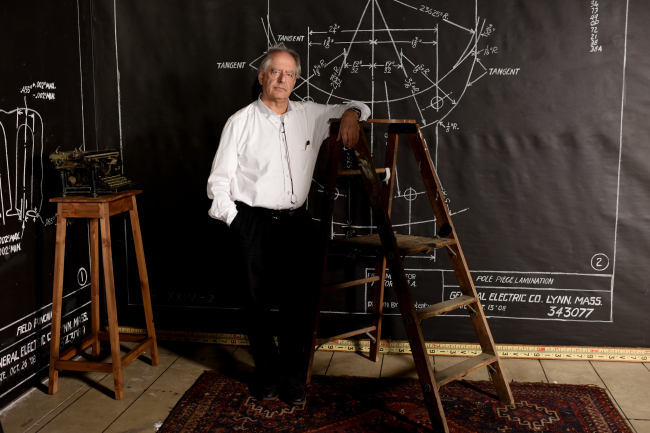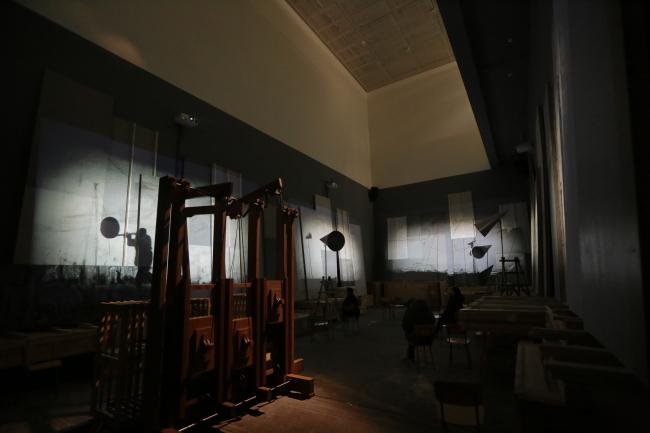The day before the opening of South African artist William Kentridge’s solo exhibition “Peripheral Thinking” at the Seoul branch of the National Museum of Modern and Contemporary Art, everything was in disarray.
Kentridge’s silhouette cutouts, used in his animation works, hung on spots of the wall that would not conventionally be considered exhibition space. There was a cacophony of sounds, some musical and some not, quietly but consistently playing in a ringing jumble throughout the halls. Lights flickered, and wooden crates were piled on the floor.
As it turns out, this was exactly what the prolific Kentridge, 60, known for his artistic interpretations of South African social issues, apartheid among them, had in mind.
 |
William Kentridge (MMCA) |
“I’m more interested in the exhibition having a roughness, messiness that corresponds to the messiness of thinking, of not being perfectly ordered but allowing connections to happen between images, films, rooms of the exhibition,” Kentridge told a group of reporters ahead of a tour through the halls on Nov. 30.
He said he saw his exhibition as an expansion of his studio, which in turn was an expansion of his mind.
“(The studio) is an enlargement of what happens in our heads. Different ideas connecting, different images in our heads, ideas being sent through our eyes, our ears, our memories, our dreams.”
“Think of the exhibition as a demonstration of the studio. Again, all the different thoughts that go through one’s head, in the expanded form in the exhibition itself.”
Kentridge’s first solo exhibition in Korea features 108 pieces of work, including videos, drawings, installations and etchings among others, with subject matters spanning questions of art, social issues, politics and philosophy.
 |
"Refusal of Time" by William Kentridge (MMCA) |
Kentridge’s diversity of subjects and materials perhaps stems from his belief that the studio is a place that produces interpretations of the world around the artist.
“You can think of the studio as a place where the world is invited in ... and it is rearranged in the studio, edited, things taken, other things left out and sent out into the world,” he said. His world was that of South Africa during the apartheid, and the struggle to move on to a new era once apartheid was abolished.
“There’s always a mixture of personal stories and what’s happening around in society, because it was so present. That’s what came into the studio all the time, and still comes into the studio -- the political world meeting the personal world,” he said. “The politics of South Africa came into the studio to infect all the work that was done.”
The ideas that enter the studio have “explosive clashes” with certain materials to become art. “The idea by itself is never enough, and the material -- ink, brush, cardboard, video -- needs something to meet. ... Working as an artist is always about a physical activity, it’s thinking through the body. It’s not simply sitting at a table, working out an idea in the abstract.”
The “Peripheral Thinking” exhibition clearly shows Kentridge’s belief in the physical importance of art. The spaces are filled with installations that he touched and rearranged as he walked through -- the walls covered in dancing silhouettes and video installations playing in makeshift rooms draped with dark curtains.
Key pieces of the exhibit include “The Refusal of Time” (2012), a five-channel video work on the ideas of fate and inevitability; “Cutouts for ‘More Sweetly Play the Dance,’” sculptures used in the famous 2015 animated work; and “Black Box/Chambre Noire,” a model theater with drawings, puppets and film focusing on the Herero Massacre of 1904-1907 in what is now Namibia.
“William Kentridge - Peripheral Thinking” runs at the Seoul branch of the National Museum of Modern and Contemporary Art until March 27. For more information, visit
www.mmca.go.kr.
By Won Ho-jung (
hjwon@heraldcorp.com)









![[Today’s K-pop] Blackpink’s Jennie, Lisa invited to Coachella as solo acts](http://res.heraldm.com/phpwas/restmb_idxmake.php?idx=644&simg=/content/image/2024/11/21/20241121050099_0.jpg)